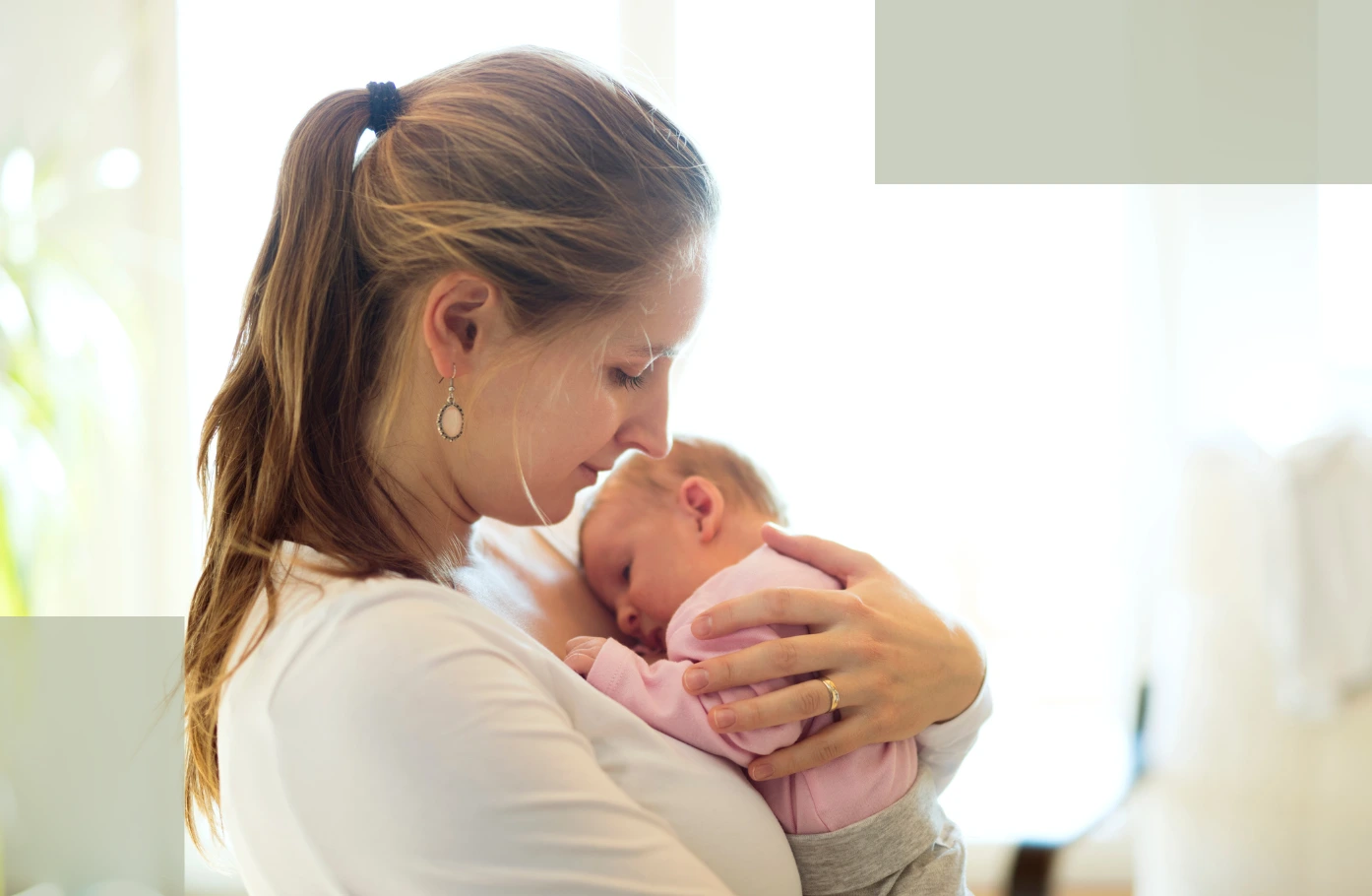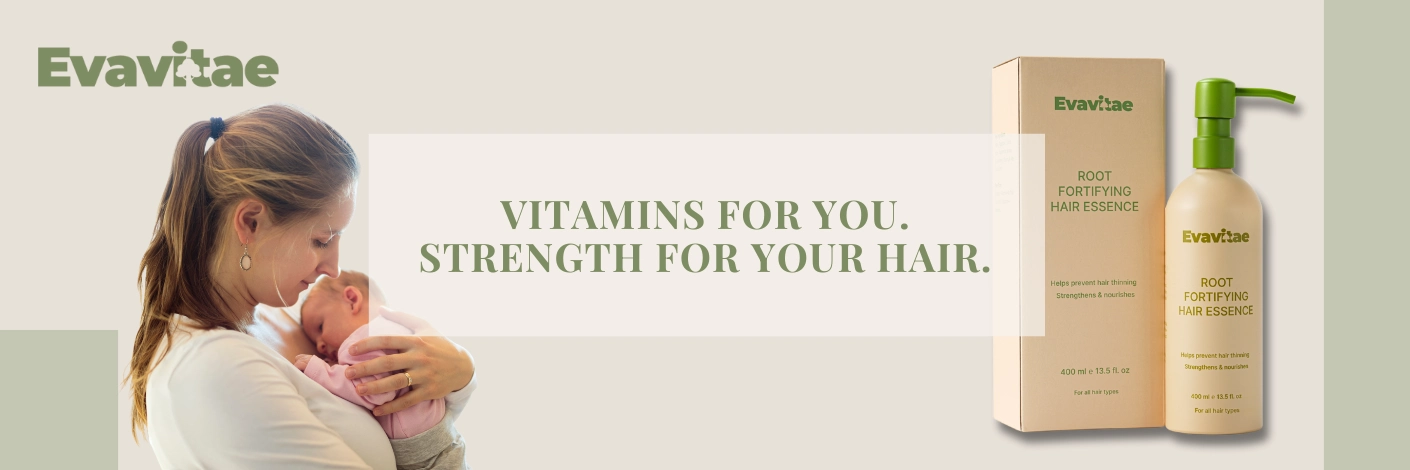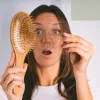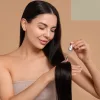
1. Why Postpartum Hair Loss Happens
Almost every new mom experiences some degree of hair loss after giving birth.
It’s not a sign of something going wrong — rather, it’s your body’s way of resetting after pregnancy.
During pregnancy, estrogen levels rise significantly.
This hormone extends the “growth phase” (anagen) of hair, which is why many pregnant women notice fuller, shinier, and thicker hair.
However, once the baby arrives, estrogen levels drop rapidly.
Without this hormonal support, many follicles enter the “resting phase” (telogen), and within 2–4 months, the accumulated hair begins to shed — a phenomenon known as Postpartum Telogen Effluvium.
The good news: it’s temporary, usually lasting 6–12 months.
But if your body is low in key nutrients (like iron, zinc, or protein), or if you use harsh shampoos, the recovery process can take longer — sometimes leading to persistent thinning.
Another major factor is stress and lack of sleep.
New mothers often experience disrupted sleep, fatigue, and emotional stress, which increase cortisol (the stress hormone).
Elevated cortisol can disrupt the hair cycle, inflame follicles, and weaken scalp balance — leading to excess shedding or oil imbalance.
According to Mayo Clinic, increased shedding for several months postpartum is common and typically resolves over time.
This isn’t permanent hair loss — it’s your follicles responding to hormonal fluctuation.
However, if shedding continues beyond a year or comes with itchiness, excess oil, or inflammation, it may point to nutrient deficiency or hormonal imbalance.
In such cases, testing ferritin, vitamin D, and zinc levels can help uncover the root cause.
In short:
Postpartum hair loss doesn’t mean your follicles are dead — they’re waiting for your body to recover.
Balanced nutrition plus gentle, science-based hair care can help restart the growth cycle naturally.
2. How Nutrient Deficiency Affects Hair Growth
During pregnancy and breastfeeding, your body prioritizes nourishing the baby.
This often leaves mothers in a state of nutritional deficit, which directly affects hair follicle metabolism.
Nutrient | Function | Deficiency Symptoms | Best Sources |
Iron | Supports hemoglobin and oxygen delivery to follicles | Fine, weak hair; fatigue; dizziness | Lean meats, spinach, lentils, iron supplements |
Zinc | Regulates keratin formation and sebum balance | Flaky scalp, brittle hair | Shellfish, pumpkin seeds, nuts |
Vitamin D | Controls follicle cycling and new growth | Thinning on crown, seasonal shedding | Sunlight, fortified milk, fish oil |
B Vitamins (Biotin, B12, B6) | Boost keratin production and cellular energy | Dull, fragile hair; tiredness | Eggs, grains, leafy greens |
Protein | Builds keratin structure for strands | Reduced growth, thinner hair | Fish, beans, dairy |
Omega-3 Fatty Acids | Anti-inflammatory, strengthens scalp barrier | Dry, itchy scalp | Fatty fish, flaxseed, walnuts |
The NIH notes that iron zinc deficiency hair loss is one of the most common postpartum issues — especially for women who have heavy menstruation, restricted diets, or prolonged breastfeeding.
Biotin is one of the key nutrients included in many prenatal formulas, but its real impact depends on how it’s used and supported. Learn more in our detailed guide on whether Biotin truly helps hair growth and how to complement it with gentle topical care.
Choosing the right prenatal or postnatal vitamins helps replenish these nutrients for faster recovery.
3. What Makes the Best Prenatal Vitamins for Hair Growth?
Not all prenatal vitamins directly support hair regrowth.
When choosing the best prenatal vitamins for hair growth, focus on key nutrients proven to strengthen follicles:
Key Ingredient | Why It Matters | Evidence |
Biotin (Vitamin B7) | Reinforces keratin and reduces breakage | |
Iron + Folic Acid | Improves circulation and cell renewal | |
Vitamin D3 | Regulates follicle cycle and reduces inflammation | NIH studies link low D levels to telogen effluvium |
Zinc + Vitamin C | Antioxidant protection, enhances repair | Promotes collagen formation and nutrient absorption |
Omega-3 | Strengthens scalp barrier and balances oil | Supports follicular microcirculation |
Tip: Avoid excessive doses of iron or vitamin A — both can cause scalp irritation or even worsen shedding if taken unnecessarily.
4. From Nutrition to Hair Care: The Postpartum Recovery Routine
Lasting results come from both internal and external support:
Eat right + Wash right.
Phase | Internal Focus | External Care |
Months 1–3 | Replenish iron, zinc, vitamin D | Use sulfate-free, amino acid–based shampoo to avoid irritation |
Months 4–6 | Add Biotin and protein for follicle strength | Choose a gentle formula with Niacinamide + Ginseng |
After 6 months | Maintain omega-3 and balanced diet | Continue scalp massages and mild, hydrating cleansing |
Try Evavitae Anti-Hair Loss Shampoo
Its formula blends Biotin, Niacinamide, Ginseng Extract, and Batana Oil —
supporting scalp repair, boosting microcirculation, and restoring balance for both postpartum and sensitive scalps.
5. Why Evavitae Is Ideal for Postpartum Care
Evavitae’s amino-acid-based cleansing system (Amino Acid + Disodium Laureth Sulfosuccinate + Cocamidopropyl Betaine) is designed to protect, not strip.
Benefits:
- Free from sulfates, silicones, and artificial colorants
- Maintains scalp’s natural lipid barrier — no “stripped-dry” feeling
- Biotin and Panthenol restore keratin structure
- Ginseng extract improves energy metabolism and extends the growth phase
According to the Mayo Clinic,
gentle, sulfate-free cleansers are safe and effective for postpartum use — helping new moms maintain scalp health while minimizing irritation.
6. Key Takeaways
- Postpartum hair loss is temporary — real recovery requires nutrition + care.
- The best prenatal vitamins for hair growth provide Biotin, Iron, and Zinc to rebuild strength.
- Pair them with a gentle, balanced hair care routine to restore long-term scalp health.
Learn more in the Evavitae Hair Care Blog.
For a full overview of causes, remedies, and safe products, visit our Comprehensive Postpartum Hair Loss Resource.
Evavitae products are now available exclusively at www.evavitae.com.




Add comment
You must be logged in to post a comment.